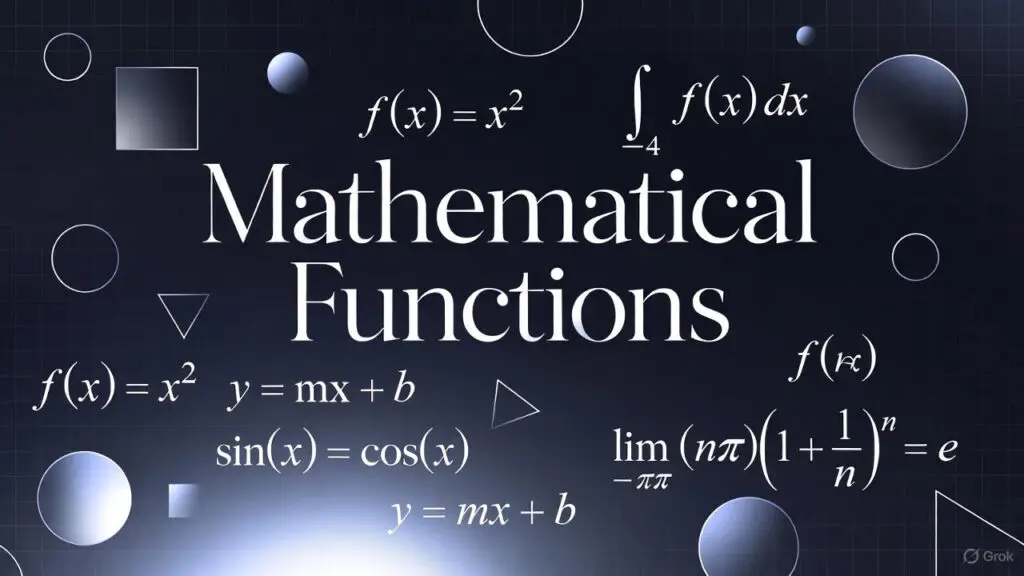“Mathematics is the study of functions.”
— Vito Volterra
Theory
Functions are evidently important in mathematics. The definition of a function follows from set theory and it is worth exploring the derivation. Commonly a function is seen as something like ![]() . However, their definition is grounded in set theory.
. However, their definition is grounded in set theory.
A function should be seen as an assignment of an element of a set ![]() to an element of a set
to an element of a set ![]() with some restrictions. This idea can be stated as:
with some restrictions. This idea can be stated as:
![]()
Where ![]() is the function. The image of
is the function. The image of ![]() is the element in the set
is the element in the set ![]() given by
given by ![]() .
.
The set ![]() is the domain of the function
is the domain of the function ![]() . The range is the set of all elements of
. The range is the set of all elements of ![]() that are mapped to by elements of
that are mapped to by elements of ![]() . The function
. The function ![]() forms a set of ordered pairs for which
forms a set of ordered pairs for which ![]() is true. Let
is true. Let ![]() be the range such that
be the range such that ![]() .
.

A singled valued function can therefore be viewed as a set of ordered pairs for which ![]() is true. These ordered pairs are a subset of the cartesian product of
is true. These ordered pairs are a subset of the cartesian product of ![]() and
and ![]() where
where ![]() . Every element of
. Every element of ![]() must map to an element of
must map to an element of ![]() . Further, to be a function, an element
. Further, to be a function, an element ![]() of
of ![]() must map to only one value
must map to only one value ![]() in
in ![]() .
.
![]()
In the above definition, ![]() in
in ![]() need not map to an unique element
need not map to an unique element ![]() of
of ![]() . If each
. If each ![]() does have a unique
does have a unique ![]() then the function is called injective.
then the function is called injective.
Definition: Let ![]() and
and ![]() be sets and
be sets and ![]() .
. ![]() is injective if every
is injective if every ![]() maps to a unique
maps to a unique ![]() .
.
![]()
For the map ![]() if the image of
if the image of ![]() is all of
is all of ![]() then
then ![]() is called surjective.
is called surjective.
Definition: Let ![]() and
and ![]() be sets and
be sets and ![]() . If every element
. If every element ![]() in
in ![]() is the image of an element
is the image of an element ![]() in
in ![]() then
then ![]() is surjective.
is surjective.
![]()
Definition: If a function is both injective and surjective then the function is bijective
Composition of functions.
A composition of functions is to perform one function after another. Say ![]() and
and ![]() are functions. Then function composition gives a new function
are functions. Then function composition gives a new function ![]() , for example,
, for example, ![]() . This means
. This means ![]() is the function of
is the function of ![]() applied after
applied after ![]() . This means
. This means ![]() . An alternative way of stating this is
. An alternative way of stating this is ![]() .
.
Consider the composition of three functions:![]()
Hence composition of functions is associative. Note that the composition of functions is not necessarily commutative.
Discussion
Functions needs note revolve around numbers. For example, in a monogynous society if a set of people A have partners in the set B then the partner function maps an element of A to B. If sets A and B are the same size then this would also be a bijective function. That is, there is a one to one map between each element of the two sets. If the society is not monogynous then the partner map is not a function as a member of set A could map to many members of set B which breaks the definition of a function.
If a function is bijective then there is an inverse function that maps an image back to the original element in the domain.
A common function in mathematics is ![]() . This is a function that takes an element of the real numbers and maps it to only one element of the positive real numbers. However, this function is not injective. For example
. This is a function that takes an element of the real numbers and maps it to only one element of the positive real numbers. However, this function is not injective. For example ![]() means
means ![]() maps to either
maps to either ![]() or
or ![]() . This reverse process is not a function. Therefore no inverse exists. There are many functions that are not injective, for example
. This reverse process is not a function. Therefore no inverse exists. There are many functions that are not injective, for example ![]() .
.
Composition of functions is used in the chain rule of differentiation encountered in elementary calculus.
The bijective relationship is the core of understand the ‘size’ of a cardinal number. Two sets have the same size if a bijective map can be formed between the elements of each set. This means that we only need to define a standard set for each number and every other set can be compared to this to give a concept of ‘size’.

